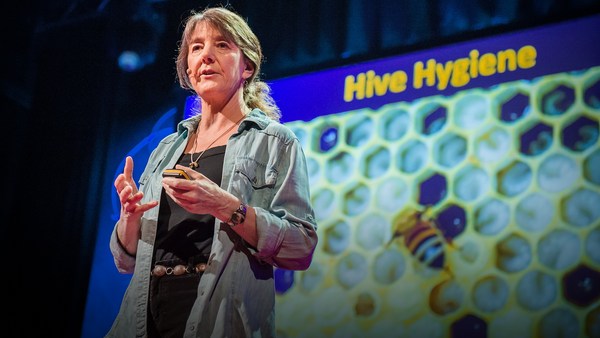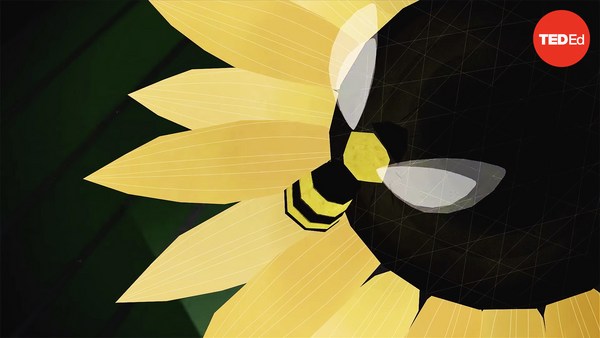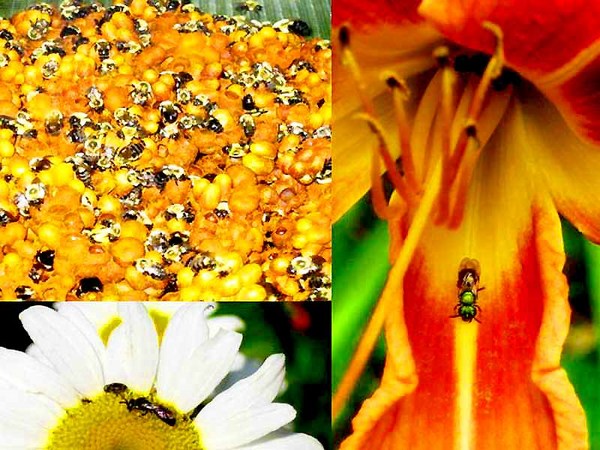(Music)
These bees are in my backyard in Berkeley, California. Until last year, I'd never kept bees before, but National Geographic asked me to photograph a story about them, and I decided, to be able to take compelling images, I should start keeping bees myself. And as you may know, bees pollinate one third of our food crops, and lately they've been having a really hard time. So as a photographer, I wanted to explore what this problem really looks like. So I'm going to show you what I found over the last year.
This furry little creature is a fresh young bee halfway emerged from its brood cell, and bees right now are dealing with several different problems, including pesticides, diseases, and habitat loss, but the single greatest threat is a parasitic mite from Asia, Varroa destructor. And this pinhead-sized mite crawls onto young bees and sucks their blood. This eventually destroys a hive because it weakens the immune system of the bees, and it makes them more vulnerable to stress and disease.
Now, bees are the most sensitive when they're developing inside their brood cells, and I wanted to know what that process really looks like, so I teamed up with a bee lab at U.C. Davis and figured out how to raise bees in front of a camera. I'm going to show you the first 21 days of a bee's life condensed into 60 seconds.
This is a bee egg as it hatches into a larva, and those newly hatched larvae swim around their cells feeding on this white goo that nurse bees secrete for them. Then, their head and their legs slowly differentiate as they transform into pupae. Here's that same pupation process, and you can actually see the mites running around in the cells. Then the tissue in their body reorganizes and the pigment slowly develops in their eyes. The last step of the process is their skin shrivels up and they sprout hair. (Music)
So -- (Applause)
As you can see halfway through that video, the mites were running around on the baby bees, and the way that beekeepers typically manage these mites is they treat their hives with chemicals. In the long run, that's bad news, so researchers are working on finding alternatives to control these mites.
This is one of those alternatives. It's an experimental breeding program at the USDA Bee Lab in Baton Rouge, and this queen and her attendant bees are part of that program.
Now, the researchers figured out that some of the bees have a natural ability to fight mites, so they set out to breed a line of mite-resistant bees. This is what it takes to breed bees in a lab. The virgin queen is sedated and then artificially inseminated using this precision instrument. Now, this procedure allows the researchers to control exactly which bees are being crossed, but there's a tradeoff in having this much control. They succeeded in breeding mite-resistant bees, but in that process, those bees started to lose traits like their gentleness and their ability to store honey, so to overcome that problem, these researchers are now collaborating with commercial beekeepers. This is Bret Adee opening one of his 72,000 beehives. He and his brother run the largest beekeeping operation in the world, and the USDA is integrating their mite-resistant bees into his operation with the hope that over time, they'll be able to select the bees that are not only mite-resistant but also retain all of these qualities that make them useful to us.
And to say it like that makes it sound like we're manipulating and exploiting bees, and the truth is, we've been doing that for thousands of years. We took this wild creature and put it inside of a box, practically domesticating it, and originally that was so that we could harvest their honey, but over time we started losing our native pollinators, our wild pollinators, and there are many places now where those wild pollinators can no longer meet the pollination demands of our agriculture, so these managed bees have become an integral part of our food system.
So when people talk about saving bees, my interpretation of that is we need to save our relationship to bees, and in order to design new solutions, we have to understand the basic biology of bees and understand the effects of stressors that we sometimes cannot see. In other words, we have to understand bees up close.
Thank you.
(Applause)





